MXA RACE TEST: THE REAL TEST OF THE 2021 HONDA CRF250

Q: FIRST AND FOREMOST, IS THE 2021 HONDA CRF250 BETTER THAN THE 2020 CRF250?
A: Is this deja vu? Why does the 2021 CRF250 look identical to the 2020 CRF250? Because it is, all the way down to the graphics. Honda has done this in the past. We said this in our 2017 CRF250 test: “If you rolled a 2017 Honda CRF250 and a 2016 Honda CRF250 into Honda’s R&D department and asked Honda’s most brilliant designer to tell the 2017 from the 2016, he couldn’t do it.” There is a pattern here, but it doesn’t make total sense. Both years that Honda made zero changes to its 2017 and 2021 CRF250s, it was coming out with an all-new CRF450. By not spending any money on the 2021 CRF250, Honda was able to spend every penny of its R&D budget on its redesigned CRF450. Yes, it left the CRF250s out to dry. It’s a strange business model to give up on the CRF250 in hopes of making it up on the CRF450. Does this business strategy work? Yes and no. There is a lot of buzz for the all-new CRF450, which should translate into increased sales in 2021. On the other hand, there is no buzz for the “Dolly the clone” CRF250 from the year before. This is self-sabotage. Hasn’t Honda figured out that a modest attempt to spiff up your models with bold new graphics goes a long way in the eye of the buyer? Guess not.
Q: WHAT HAS HONDA DONE TO ITS CRF250 SINCE IT REVAMPED IT IN 2018?
A: Honda had no choice but to spend millions of R&D dollars in an effort to fix its then-all-new 2018 CRF250. It was a flop. The bike was a dud in the engine department. It handled well, but in the 250 class it’s all about power, baby! The 2018 CRF250 offered no bottom or mid, and the top-end power was subpar at only 40.70 ponies. That’s 3-1/2 horsepower down in comparison to the leader of the class, which in 2018 was the Husky FC250. The best word to describe the 2018 CRF250 was “boring.” The dull power made it feel as if we were riding with the rear brake on. We checked multiple times to make sure we weren’t.
Honda went straight to the drawing board to see where things went wrong. The engineers couldn’t start from scratch again like they did for the 2018 CRF250, as Honda’s accountants wouldn’t allow it. The budget for the CRF250 was already spent. So, Honda had to pull money from somewhere else. Engineers were stuck trying to figure out ways to enhance the CRF250 powerband on a minuscule R&D budget. Here is a list of what Honda changed on the CRF250 in 2019 and 2020.
(1) Cam profile. In both 2019 and 2020, Honda changed the cam profile. Even though the 2019 cam was developed by the HRC 250 Grand Prix race team in Europe, it wasn’t as good as what the in-house testers developed for the 2020 model.
(2) Exhaust ports. In 2019, Honda changed the geometry of both the intake and exhaust ports to move the power around.
(3) Muffler. In 2019, the right-side exhaust pipe was shortened 50mm, and in 2020 the muffler got larger perforation holes in the perf-core.
(4) Head pipe. In 2020, the resonator on the right header was removed for improved flow, and the head pipe diameter was reduced.
(5) Ignition timing. In 2020, the timing at 8000 rpm was updated.
(6) Engine cooling. In 2019, Honda realized it needed to cool down engine temperatures. The engineers did this by adding a nozzle to the piston oil jet and expanded the left side radiator by 5 percent at the top.
(7) AC generator. The AC generator was redesigned to reduce weight and friction loss in 2019.
(8) Clutch. The weak clutch of 2018 got updated in 2019 and 2020. In 2019, it received an updated basket and judder spring that were used in the 2018 recall, and in 2020 the clutch plates were made thicker, the clutch springs were made stiffer, and oil capacity was upped 18 percent.
(9) Piston. In 2019, the bridged-box piston design featured a reinforcing structure between the skirts and the wrist-pin bosses.
(10) Throttle body. A smaller 44mm Keihin throttle body replaced the 46mm throttle body in 2019.
(11) Sensor. In 2020, a gear-position sensor was added to allow different ignition maps for each of the five gears.
(12) Transmission. Second gear was made taller in 2020 (going from a 1.80 to 1.75 ratio), and second and third gear were WPC-treated.
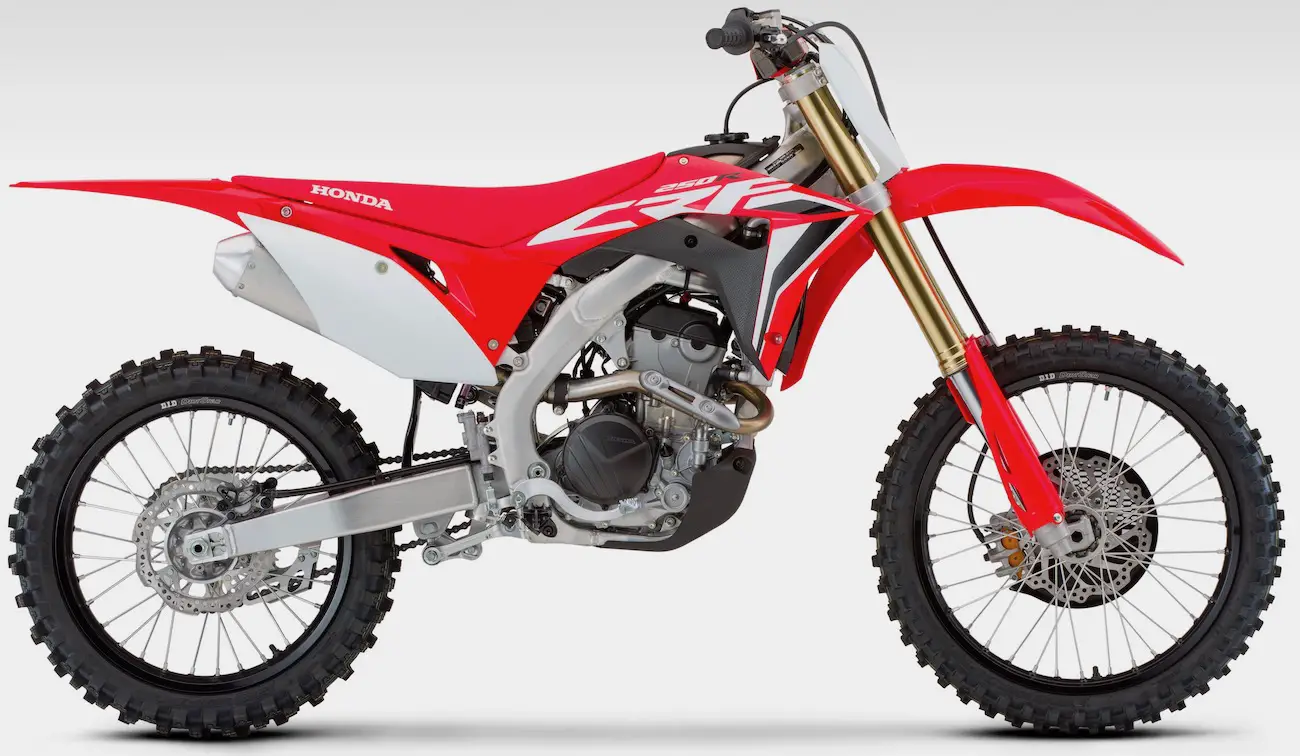 The 2021 Honda CRF250 is the 2020 CRF250.
The 2021 Honda CRF250 is the 2020 CRF250.
Q: DID THE CRF250 ENGINE GET BETTER WITH ALL ITS CHANGES FROM 2018 TO 2020?
A: Yes. All the engine updates that were made in 2019 and 2020 made a big difference on the track. The engine made more power everywhere on the dyno curve over the 2018 model. In 2020, the CRF250 produced 42.98 horsepower at 13,800 rpm, which was over a 2-pony improvement since 2018. Sounds like a good number, right? In 2018, we would have said yes; however, when Honda got caught behind the eight ball, the other manufacturers smelled blood and developed improved machines for 2020. The CRF250 ranked fourth in peak power in 2020 ahead of the Yamaha YZ250F and the already-dated Suzuki RM-Z250.
Testers enjoyed riding the CRF250 with its improved powerband. It was easy to ride, as long as you kept the momentum moving forward and were in the right gear. The trouble was that
when the MXA test riders stacked it up against the blue, orange, white, and green bikes, the fun stopped there. The CRF250 is not a competitive machine when raced head-to-head against its competition.
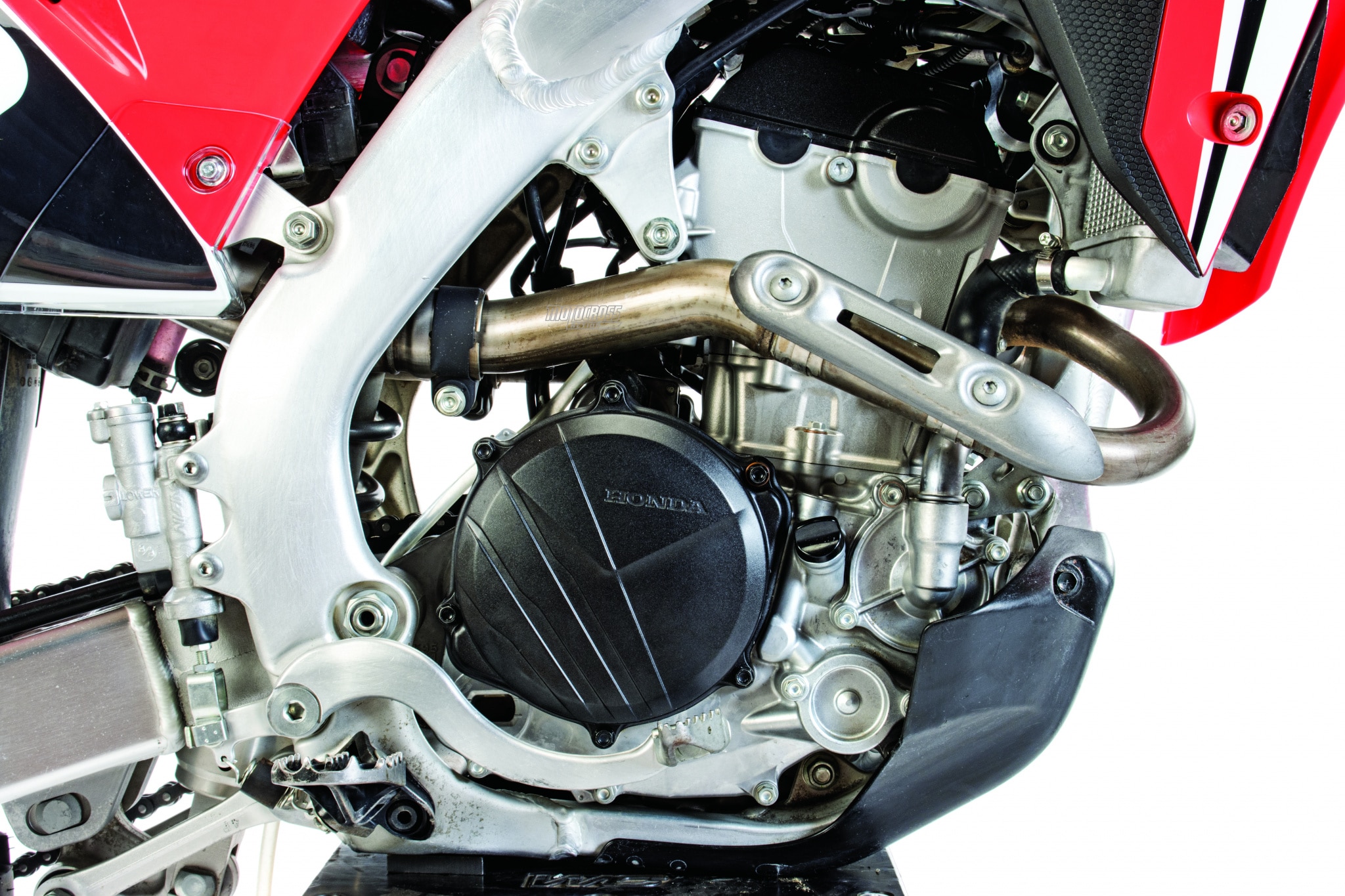
Q: WHAT IS THERE TO LIKE ABOUT THE 2021 CRF250?
A: The handling. This is one of the best-handling bikes in the 250 four-stroke class. It suits a wide range of riders. The suspension is reminiscent of the Kayaba SSS components. How so? Because most riders can jump on the bike and feel at home with minimal changes. For riders who lack the knowledge and experience to set up their own bikes, the CRF250 and YZ250F are just about dummy-proof. It is hard to get it wrong.
The Showa suspension is plush, really plush. The suspension is on the soft side and the forks dive at times; however, they are hard to bottom. While the plush forks have a lot of movement, are they absorbing the rough terrain in their path? For most riders, the excessive movement isn’t a bad thing. It felt like we were riding on cloud nine. We could relax our grip on the bars and enjoy the ride. Pro test riders prefer more input from the ground and less movement fore and aft. The faster testers wanted stiffer settings.
What helps the plush suspension is the frame that it is attached to. The CRF250 frame doesn’t flex under a load, which improves the suspension traits and the consistency of cornering. Like its big brother the CRF450, it has great turn-in attributes, but whereas the CRF450 wants to stand up at the apex of the corner, the CRF250 digs in and stays planted. This is a bike that corners with precision, although it comes at a cost. At speed, the bike will shake for our lighter test riders. Bigger and stronger testers could fight it off.
Q: HOW DOES THE BIKE STACK UP AGAINST ITS COMPETITION IN 2021?
A: The Japanese manufacturers must have made a pact long ago about production cycles to save money. Doesn’t it seem strange that Honda, Kawasaki, Suzuki and Yamaha would all go on four-year production cycles? Meaning every four years they would come out with an all-new bike. Sure, they would change small things within that four-year span with updated suspension settings, different gearing, new tires or flashy graphics, but engine overhauls or chassis changes were nixed by the powers that be. The four-year production cycle worked great when the only players were Yamaha, Kawasaki, Suzuki and Honda. The budgets could be set in advance and everybody knew when the other guy’s new models were coming out. All was going smoothly until KTM ripped the rug out from under the Japanese manufacturers. KTM disrupted the industry by updating bikes whenever they felt like it. They really threw a wrench into the Japanese manufactures’ four-year production cycles. Even worse for the Big Four was that KTM came out with the KTM 450SXF Factory Editions in 2012. That spooked the Japanese, because this was a brand-new model that had been brought to the showroom in only six months
Ever since then, the Japanese brands have been playing catch-up with the Austrian juggernaut, who not only came out with new engines whenever it felt like it but grew from one brand to three brands (KTM, Husqvarna and GasGas). And all three were serious competition, because they were all built with serious components. What does this mean for the 2021 Honda CRF250? It means that it will not only be a year behind Yamaha and Kawasaki in 250 development, but it will be two to three years behind the Austrian trio. Stagnation at Honda on the CRF250 gave the competition the opportunity to strike.
The 2021 CRF250 offers a decent powerplant, but it doesn’t shine in any area of the power curve. It is still lethargic off the bottom, needs a wake-up call from the clutch in the midrange and starts to wake up from its nap in the upper echelons of the powerband. This is a long, drawn-out process. It takes precious time to get into the meat of the power. By the time the CRF250 wakes up, the 250SXF, FC250, YZ250F and KX250 are long gone. Even the dated RM-Z250 can challenge the CRF250 in the right environment, which consists of tight, loamy or Supercross-style tracks.
The writing is on the wall. Honda put the 2021 CRF250 in a hole as deep as the Chuquicamata opencast mine (the biggest man-made hole in the world). From 2018 to 2020, Honda did a fairly good job with what they had to work with. The power got boosted and the powerband got broader. These 2019 and 2020 Band-Aid fixes made the CRF250 easy to ride for the masses—although the RM-Z250, YZ250F and FC250 are also easy to ride.
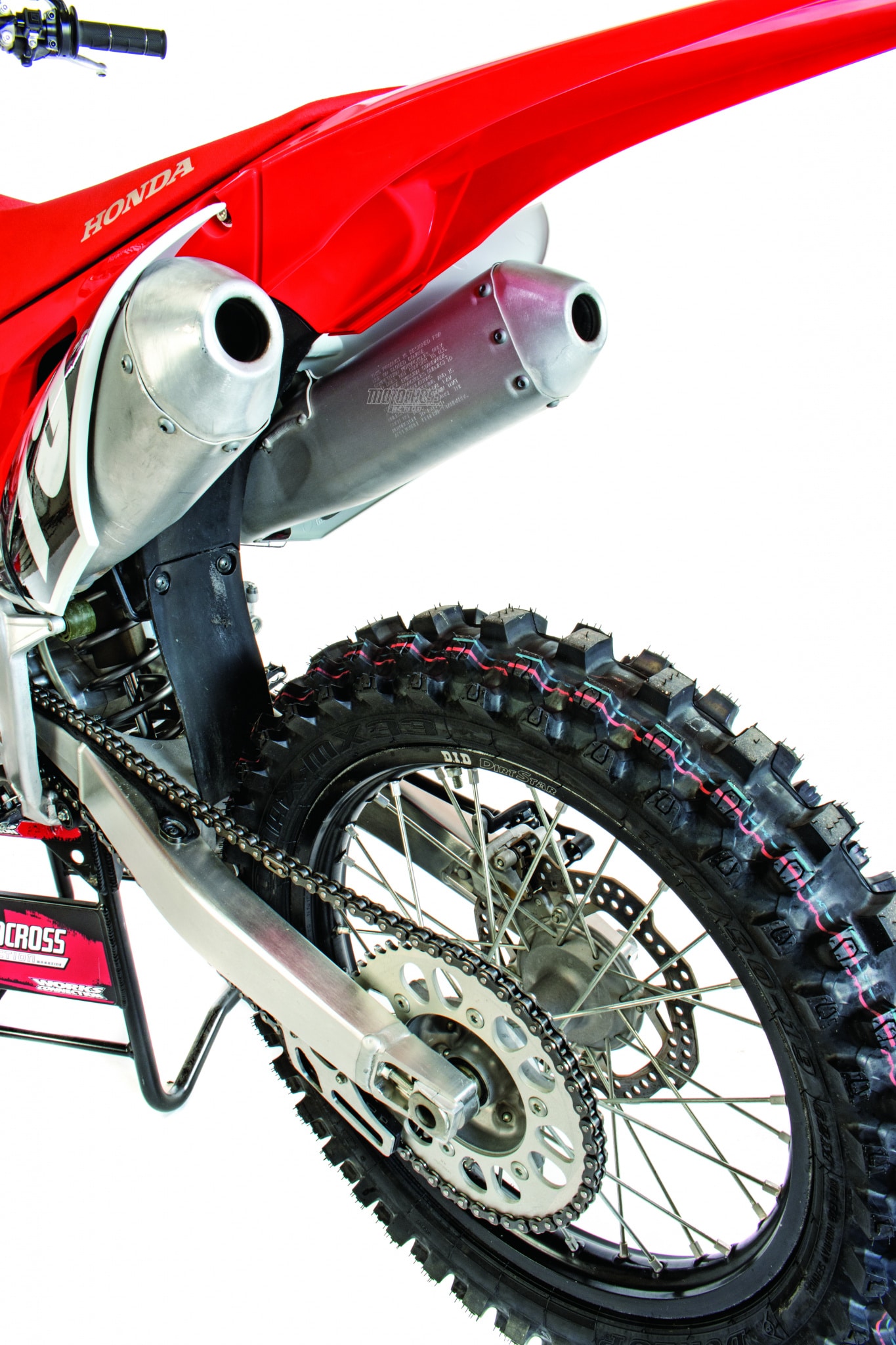
Q: WHAT DID WE HATE?
A: The hate list:
(1) Powerband. The CRF250 makes decent power on the dyno, but on the track the power is slow-revving. By the time it gets up to speed, the competition already went by.
(2) Weight. At 228 pounds, the CRF250 would not even be the lightest bike in the 450 class. It is 10 pounds heavier than the lightest 250 four-stroke and 5 pounds heavier than the lightest 450 (both of which are KTMs).
(3) Engine covers. The paint on the ignition and clutch cover gets scratched on the first ride.
(4) Maps. We want a more distinct difference between the three CRF250 maps. Most testers couldn’t feel a big difference.
(5) Dual exhaust. Unlike the CRF450’s one-into-two dual exhaust (gone for 2021), the CRF250 actually has two different exhaust pipes and mufflers running down both sides of the bike. If the CRF250 had the best power in the class, we could overlook the complexity, weight and replacement cost of twice pipes, but it doesn’t.
(6) Rear fender. The rear fender is weak and will eventually break if you grab it to lift the bike onto the stand. We lift it by the hot muffler.
(7) Titanium gas tank. Making the gas tank out of titanium and then covering it with plastic is like wearing suspenders to hold your belt up. At least if we could see more than a smidgen of titanium it would have a coolness factor.
Q: WHAT DID WE LIKE?
A: The like list:
(1) Handling. This is the CRF250’s best trait. It doesn’t wag or wiggle, and it turns on a dime—although it will shake at speed in the rough.
(2) Suspension. The Showa components are dummy proof. It is hard to find a bad setting.
(3) Clutch. The stiffer springs, better fiber plates and additional oil that were added in 2020 made a weak clutch into something to be proud of.
(4) Front brake. This is a good front brake‚ maybe not Brembo good, but it will get the job done.
Q: WHAT DO WE REALLY THINK?
A: Let’s start off by saying that the 2021 CRF250 is a good bike. It does nothing catastrophically wrong; it just doesn’t do anything great. It has an excellent chassis with pleasant suspension attached to it. It offers a clutch that works, brakes that stop and an engine that has a powerband without any dips or valleys. Its cockpit is compact and best suited to smaller riders. The 2021 CRF250 is an easy bike to feel comfortable on. Younger riders jumping up to big bikes or lower-level riders will appreciate the CRF250. On the other side of the coin, serious racers will overlook its premium handling and plush suspension and focus on its mundane powerplant. If you are a serious racer, you will need to dump at least a few thousands bucks into the CRF250 just to make it competitive with other brands’ stock engines.
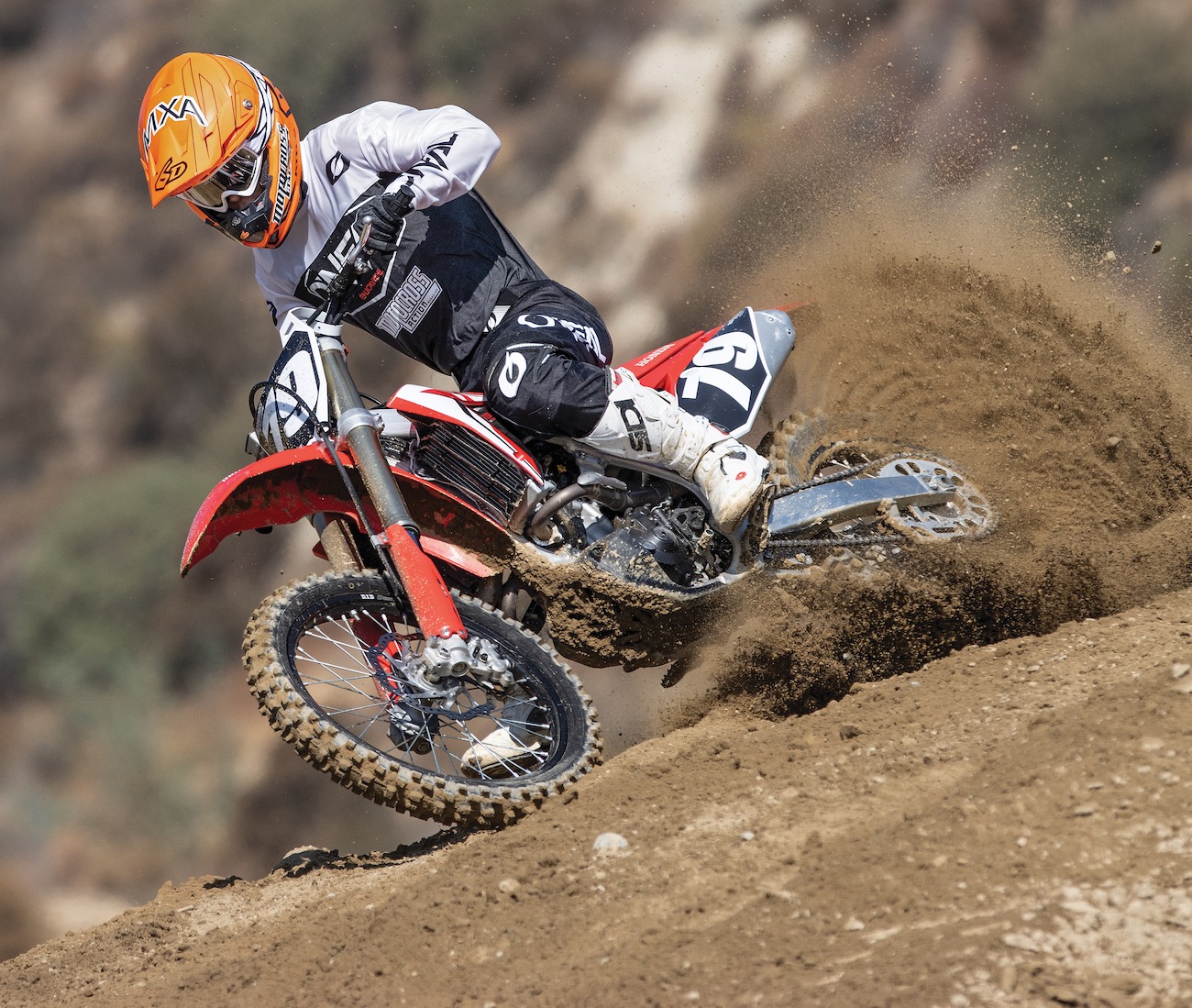 The CRF250 is a great bike for new riders or mini bike riders jumping up to big bikes. It handles well, and its suspension is great for lighter riders.
The CRF250 is a great bike for new riders or mini bike riders jumping up to big bikes. It handles well, and its suspension is great for lighter riders.
MXA’S 2021 HONDA CRF250 SETUP SPECS
This is how we set up our 2021 Honda CRF250 for racing. We offer it as a guide to help you find your own sweet spot.
SHOWA A-KIT SPRING FORKS
Honda hit the nail on the head with the valving and spring rates on the Showa coil-spring forks for the majority of 250 four-stroke riders. With the stock settings, the forks rode down in their stroke; we added a few clicks of compression to allow them to ride higher. Some of the riders also dropped the forks in the clamps 2mm to lessen oversteer. If you are experiencing oversteer, first drop the sag, then drop the forks. For hardcore racing, these are MXA’s recommended 2019 CRF250 fork settings (stock settings are in parentheses):
Spring rate: 4.8 N/mm
Compression: 7 clicks out (9 clicks out)
Rebound: 12 clicks out
Fork-leg height: 3mm
Notes: The forks worked well for the typical 250 four-stroke racer. Ride with these forks before you send them to your suspension guru. You might just be surprised by how well these forks work for your weight and skill level. If you get head-shake, push the forks down in the clamps, making them flush with the cap to slacken the head angle and get rid of the shake.
SHOWA SHOCK SETTINGS
We ran the race sag at the recommend 100mm. Overall, the stock settings are in the ballpark for most riders. For hardcore racing, these are MXA’s recommended 2021 CRF250 shock settings (stock settings are in parentheses):
Spring rate: 52 N/mm
Race sag: 100mm
Hi-compression: 3 turns out
Lo-compression: 9 clicks out (11 clicks out)
Rebound: 8 clicks out
Notes: The shock is consistent. It doesn’t do anything out of the ordinary. The bike does its best cornering at 100mm of sag. If you want more stability at speed, go down to 105mm, but you will give up the supreme cornering response.


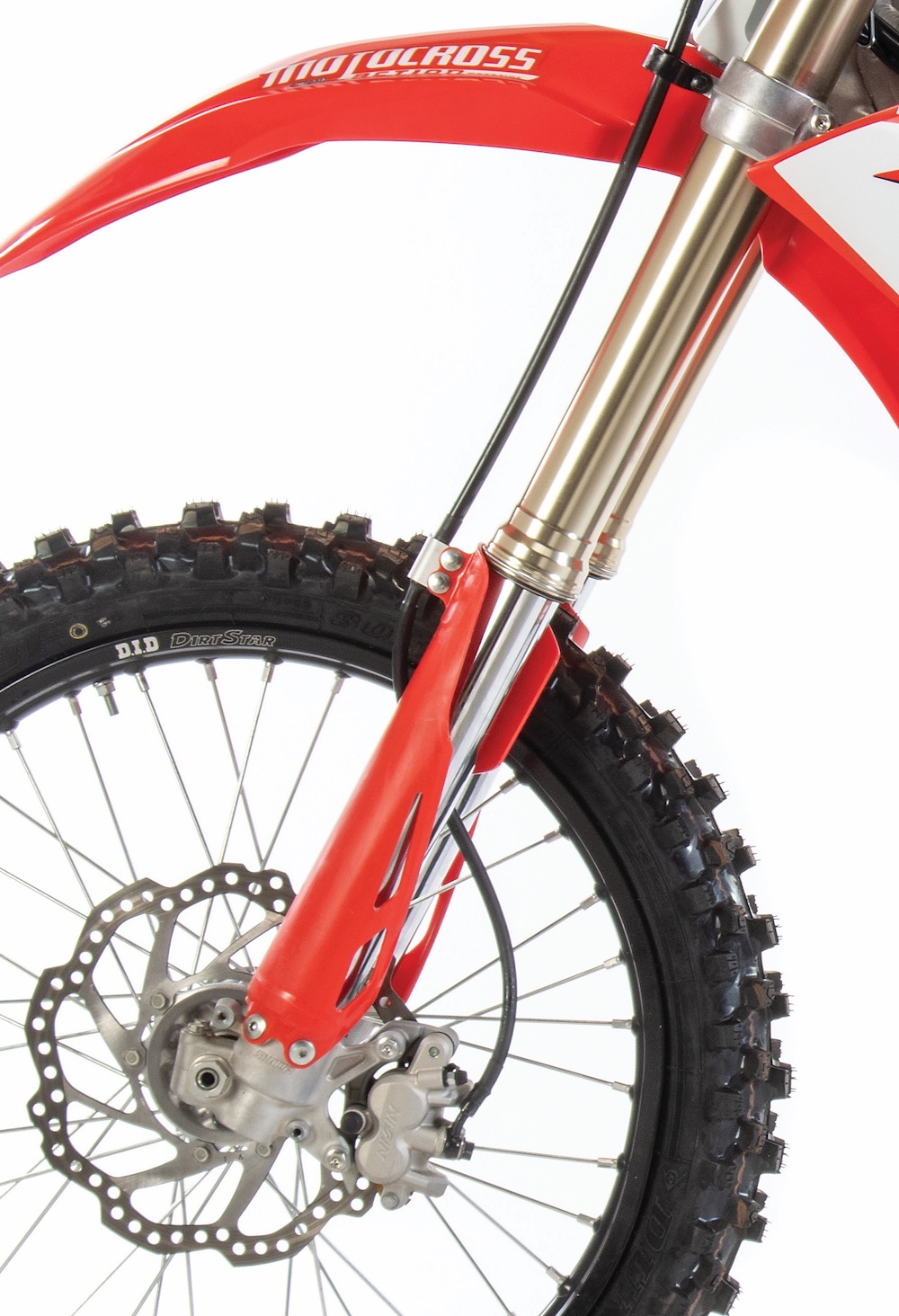



Comments are closed.